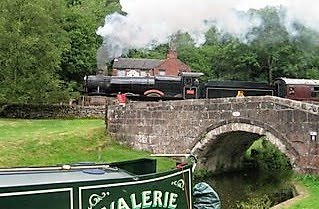I needed an old picture of Marsworth Wharf for that post and whilst searching I came across Cheddington Airfield. It appeared we were moored just 1400 yards from the old runway.
As I stand on the towpath taking this picture it`s hard to imagine working boats passing along this stretch in the 1940`s with United States American Armed Forces (USAAF) B24`s (read on) coming and going across the fields to and from missions in Europe.
The airfield close to Marsworth and Long Marston villages opened in 1942 and was named Cheddington as this was the nearest rail station--a fact that often dictated the naming of an airfield. It was used initially by the Royal Air Force (RAF) for bomber training with both Vickers Wellingtons' and Avro Ansons' being based here. Later that same year it was handed over to the USAAF who then soon after transferred to Norfolk. In 1943 once again the RAF handed the airfield back to the USAAF who returned to Cheddington. There is a lot of reading in the links I will provide so I will be brief. The first memorial is for the crash I refer to above.

In November 1944 a USAAF B24 Liberator crashed soon after take off, killing a Navigator and Gunner. Pilot Norman Landberg and Gunner George Eberwine attended the memorial ceremony at Cheddington in 2009. LINK

In December 1944 seven B24 Liberators were returning to Cheddington after their mission. Bad weather diverted four to Shrewsbury and the remaining three to Anglesey. Whilst waiting to land, one of the three ditched in the sea after running out of fuel. Eight of the crew are still to this day listed as missing. LINK

In February 1945 a B24 crashed half a mile from the runway after take off from Cheddington. Three Ariel Gunners perished. The plane had the nickname Beast of Bourbon. LINK
Another link HERE. The main information text here is under NOV 2009 and MAY 2011 but there are other references throughout the pages. Another link HERE for the Welsh disaster.
Light planes can still land on a grass strip at Cheddington; the concrete runway has long since been torn up. I can see a windsock blowing in the wind to the left side of the site.
Regardless of the connection Nb Valerie has with the U.S. I felt this was worthy of a blog post. So many brave people gave a lot, some sacrificed everything, for the freedom we have today. Those that were based here are a good example.
 |
| on the Leeds and Liverpool |
http://youtu.be/XPpIBvPz04A
As we travel the canals I will never stop being amazed at the history of the places we pass through.



1 comment:
Hi Les and Jaq, A good post and very informative. We found the same amazement at the history that was oh so close when we lived in Church Enstone for 2 years. Within 800 yards was the Enstone Airfield, an RAF base in WWII, and many more were not far away either - Chipping Norton, Upper Heyford, Weston on the Green, Kidlington, etc. One of the things I loved about living and working in Oxon was the personal nature of the history: my mum was in the WAAFS and was stationed at Kidlington (and I worked at Elsevier which was right next to Oxford Airport, formerly RAF Kidlington), mum and dad met at Weston on the Green and I drove past the turn off towards there everyday on my way to work. Dad was posted variously at WotG, and Upper Heyford - the latter we visited when boating through Lower Heyford one year and when doing a ramble while living at CE.
last year on nb Waka Huia, I had to complete mooring up duties next to Shugborough Hall on my own when David was waylaid on his way from working the lock by a guy on the towpath - on hearing David's antipodean accent, he proceeded to give him a detailed history about the WWI ANZAC training camp that was about a mile or so away. It must be investigated further. As must the National Arboretum on our next trip past there.
Mxox
Post a Comment